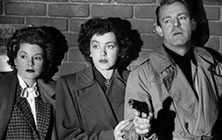|
|
|
|
Raw Deal
|
 |
|
Co-author: Cristina
Álvarez López
Under His Skin
Few
film critics intend the same thing when they invoke abstraction in cinema. For some, the reference is to the purity of
abstract painting, and its extension into experimental cinema; for others, it
points to those moments in otherwise narrative films (such as Michelangelo
Antonioni’s) when plot and characters momentarily fall away, and textures or
settings surge into the foreground. For some, abstract cinema is Stan Brakhage;
for others, it’s particularly kooky action movies where nothing makes much
logical sense and so something called “pure film” takes over.
Watching
the remarkable series of works forged by the collaboration of director Anthony
Mann and cinematographer John Alton – T-Men (1947), Raw Deal, Border Incident (1949) – we encounter a
fine-grain aesthetic in which storytelling and abstraction are hard to separate.
While the plotting follows a hardboiled minimalism familiar from many B movies,
the compositions, lighting schemes and mise
en scène of bodily movements push into startling, ultra-stylised territory.
Two
aspects of Raw Deal are especially
strange, and especially forceful. The work with light is intense, to the point
where disturbances of illumination seem to stalk the characters from one end of
the story to the other: faces are used as screens for the projection of
shadows; the lines of walls and ceiling are made to form dynamic geometries;
and camera filters create glittering, star-effects in earrings, telephones,
eyes, every reflective object.
The
other unusual aspect is the use of a voice-over narration that, for a change,
does not belong to the main character, Joe (Dennis O’Keefe). Instead, it issues
from the perspective of his lover, the ever-faithful but also ever-nervous Pat
(Claire Trevor). Her voice floats in a poetic space built on repetition and
incantation, like Joan Bennett’s similar reverie in Fritz Lang’s Secret Beyond the Door … (1947) – both of the narrative and
beyond it.
Concentrating and intensifying these two aspects (by stripping away action, and masking parts of the image), while eliminating the story’s third, major character of Ann (Marsha Hunt), results in a surfeit of abstraction that approaches the avant-garde styles of Maya Deren or some contemporary Austrian experimentalists. This is the path we pursue in our audiovisual essay on Raw Deal, Under His Skin (2017).
Different
narrative configurations then present themselves. The third point in this
“eternal triangle” is no longer a woman, but the incorporeal presence of light that
eventually becomes fire. Like other films
noir lovingly devoted (as Marc Vernet once observed) to the “blinking,
flickering and flashing of black-and-white”, Raw Deal opens its door to a faintly apocalyptic, even
science-fiction mood.
MORE Mann: Desperate © Cristina Álvarez López & Adrian Martin October 2017 |
![]()